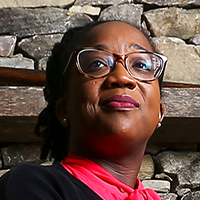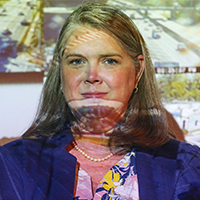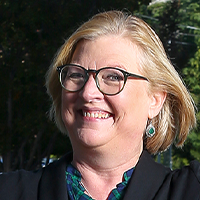Leading Women in Planning
Recognizing women leaders paving the way for inclusivity for future generations of planners

In Greensboro, North Carolina, three AICP-certified women planners currently serve as city department directors: Parks and Recreation Director Nasha McCray, AICP; Transportation Director Hanna Cockburn, AICP; and Planning Director Sue Schwartz, FAICP.
Together they reflect on their journeys into planning, how the profession has evolved in that time, and the value an AICP credential brings into their daily planning work.
AICP-certified Women Leading Planning Departments
Q: When did you discover your inner planner?

NASHA MCCRAY, AICP: Once I became a graduate student and took my first urban design course, I was hooked! It was not until I started taking planning courses that I became more curious about the complexities of community and environment and how systems work to meet the needs of residents, both today and in the future. I've always wanted to make a difference in whatever career I chose, and once I realized that I could make an impact in creating spaces and places that people liked and thrived as a planner, I was committed.

HANNA COCKBURN, AICP: As I think back, the basic characteristics of a planner have always been part of my nature, I just didn't have a name to attach to it or a way to articulate it as a career path.
My entry into public planning was heavily influenced by being a third-generation public servant. The idea of serving your community and leaving a place better than you found it was a big part of my upbringing.

SUE SCHWARTZ, FAICP: My major at the University of Pittsburgh was geography, but it was the City of Pittsburgh that had a big influence on me. It's a city of neighborhoods and as a college student, you didn't need a car because everything was accessible by transit. I ended up double-majoring in geography and urban studies because I was fascinated by how these systems worked together.
Eventually, I fell in love with planning and what impact planners have on their communities and realized I not only found my profession but also my vocation. Haven't looked back since.
Q: How has your professional planning experience affected your department's daily operations?
MCCRAY: As a planner, I understand the value and importance of utilizing data in making informed decisions, as well as how those decisions impact the broader community we serve. Even though I lead the Parks and Recreation Department, as a planner, I have been instrumental in elevating the importance of integrating planning principles in everything we do from master planning, site and facility design, and community engagement, to the way we inform and make programming and facility usage decisions.
Planning is necessary for developing parks and green spaces and providing places for physical activity and civic pride that shape successful cities.
COCKBURN: Planning informs how I approach all aspects of the department's operations. Transportation in particular presents interesting challenges — the facilities we construct and manage and the services we operate must serve the needs of today and long into the future. These investments are expensive and need to be resilient to changing demands and environmental conditions. Transportation sits at the intersection of community identity, equity, and economic development. The value proposition I shared with my staff when I started in this role is that great places have great transportation choices.
SCHWARTZ: I was fortunate that from the earliest days of my career, I worked for department directors who encouraged me to get involved in APA, first at the state and then national levels. It exposed me to techniques, policies, and tools other communities use that might help Greensboro. It also helped me develop a broad network of friends and colleagues whom I can ask for help, and bounce ideas off of, and vice versa.
Being the president of the AICP Commission, I spoke at national and chapter conferences across the country. This gave me a platform to talk about the work we were doing in Greensboro, which then garnered a lot of national attention for our planning department and city.
Q. How has the planning profession evolved for women?
MCCRAY: The communities we serve and the issues we face in these communities are not homogenous. Having different approaches — whether that is from individuals of different genders, races, cultural backgrounds, or ages — is important. I support and am encouraged by APA's Women and Planning Division, a platform for women to promote and advance techniques, knowledge, and approaches in planning that are of particular concern to women.
COCKBURN: We have come a long way throughout my career, but we still have a ways to go. Planning generally, and transportation planning in particular, has been a traditionally male-dominated profession. This is rapidly changing. At different points in my career, I have had to defend my qualifications, expertise, and right to be heard. I have often been the only woman in the room. As I have become responsible for leadership and guiding others, part of my job has been to ensure young, aspiring women are supported with opportunities to advance their careers and grow their leadership skills.
SCHWARTZ: I have been a planner for 40 years and I am proud of how this profession has evolved no matter what the influences are. There is now more focus on communication and engagement with all community stakeholders, and to do that well you need to constantly look for ways to be more effective. The profession is also more collaborative across other professions like architecture and engineering, which wasn't the case earlier in my career.
The Value of AICP Certification
McCray further shared the value of having two peers who have earned AICP certification.
"Having two peers with the American Institute of Certified Planners credential among several other phenomenal staff that have achieved this same credential benefits not just me, but the entire organization and allows us to better serve the community.
We can collaborate and make decisions at a much broader and higher level of expertise where I know my peers have the credibility, experience, and mastery of skills to do so. Having an AICP credential means that we each have committed to and made an oath to maintain a high standard of professional conduct and ethics in the work that we do, as well as a commitment that we serve the public interest, be fair, give back, and stay current with trend developments in our field."
These interviews were first shared by the City of Greensboro in celebration of National Community Planning Month in 2021. They have been edited for clarity and length and published here with permission.
Top Image: iStock / Getty Images Plus - Kruck20


